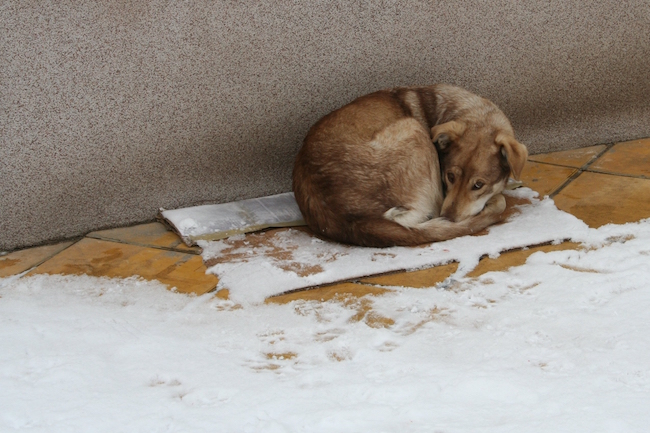
With the winter months quickly approaching and holiday travel on the way, it is important to consider how dogs handle being exposed to colder climes. Most of the time, dogs are almost always more likely to be overheated than to have low body temperature. With their dense fur coats, and tendency to race around the yard, their blood is usually pumping rapidly, keeping them warm. Since the normal body heat of a dog is several degrees above the comfortable 98 degrees Fahrenheit that humans hover near, to the untrained eye, a dog who is measured at 97-99 degrees might not be thought of as in danger. However, anything below 100 degrees may be considered the early stages of hypothermia for a pooch. Learn what canine hypothermia consists of, and what symptoms to be on the look-out for.
Hypothermia can be categorized as primary hypothermia and secondary hypothermia. The former classification occurs due to a healthy, well-functioning body being exposed to low temperatures (such as icy water, winter storms, etc.) The latter version refers to an animal being unable to produce normal amounts of body heat, because of either an illness, an injury, poison, or drugs, etc.
Levels of Canine Hypothermia
- 90-99 degrees (F): Mid-level hypothermia
- 82-90 degrees (F): Moderate hypothermia
- < 82 degrees (F): Severe hypothermia
Causes for Hypothermia
- Getting wet (i.e. being caught in the rain, falling into the sink or toilet and unable to get out, etc.)
- Being left in a cold area indoors (such as a basement or garage, etc.)
- Injury from a traumatic accident
- Dehydration or poor nutrition
- Prolonged exposure to cold
- Staying outside without proper weather protection or shelter
- Having a damp coat in heavy wind/or with a high wind chill.
Dogs that are small, or have short coats or are particularly thin are much more likely to suffer from hypothermia. If they are sick, elderly or very young the animal will also be even more greatly at risk. If a pet is hypoglycemic (low-blood sugar), has hyperthyroidism, or may be susceptible to hypothalamus disease (which monitors appetite and body heat), then he may be likely to suffer from hypothermia.
Symptoms of Hypothermia
Because hypothermia is a progressive health issue, there are certain stages of symptoms that occur as the body temperature continues to drop. These are the 3 main stages of hypothermia symptoms.
Stage 1:
- Shivering
- Burrowing or looking for a heat source (such as a stove, person, or blanket, etc.)
- Weakness
- Whimpering, evidence of stress, discomfort or sadness
Stage 2:
- Lethargy/Low energy
- Low blood-pressure
- Few movements or joint stiffness
- Shallow, short breaths
Stage 3:
- Dilated pupils
- No movement
- Dropped heartbeat
- Severe difficulty breathing
- Unconsciousness/coma
If your dog is exhibiting signs of hypothermia at any stage, review how to treat and prevent hypothermia. However, if the problem persists and your pooch is getting worse, be sure to take him to the vet.

